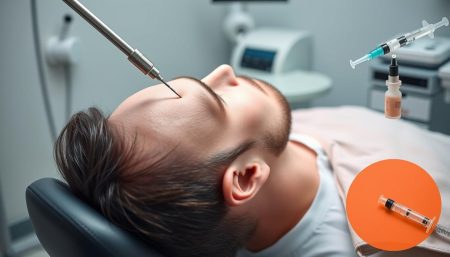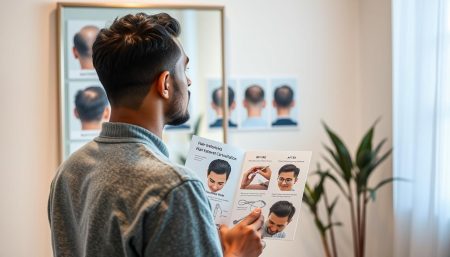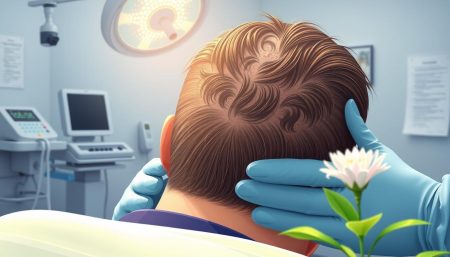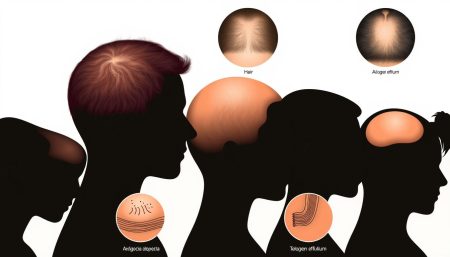Many people wonder if wearing hats can lead to hair loss. This question has sparked debates. We looked into studies from the American Academy of Dermatology, International Journal of Trichology, and the Journal of the American Board of Family Medicine to find out.
Some believe hats can cause hair loss. But is this true? This article will explore the connection between wearing hats and hair health. We’ll look at scientific studies and expert opinions to get to the bottom of it.
Key Takeaways
- Evidence regarding hat hair loss from authoritative dermatological sources.
- Differentiating between myths and scientific facts concerning hair thinning from hats.
- The role of reputable medical journals in understanding hair loss.
- Exploration of the belief that wearing hats can precipitate hair loss.
- Insight into the American Academy of Dermatology’s perspective on the matter.
- Consideration of study findings from the International Journal of Trichology and the Journal of the American Board of Family Medicine.
Unraveling the Myth: Hat Hair Loss Facts vs. Fiction
Many people think wearing hats often causes hair loss. But, it’s key to know the truth from myths to keep your hair healthy and stylish. We’ll look into studies and journals to clear up these myths.
Myth about hat hair loss often comes from stories, not facts. Let’s check out some common beliefs and see what science says to find out what’s real.
| Common Belief | Scientific Explanation | Conclusion |
|---|---|---|
| Hats cause permanent hair loss | Wearing hats wrong or too tight might block blood flow. But, normal hats don’t lead to hair loss. | No link to permanent hair thinning from hats |
| Hats don’t allow scalp to breathe | Most hats let air through, keeping the scalp cool and well-ventilated. | Hat design is vital |
| Hats lead to hat baldness | Science doesn’t support the idea that hats kill hair follicles, causing baldness. | No evidence supporting hat baldness |
Knowing these facts helps you choose hats wisely and care for your hair better. So, when you grab your favorite hat, remember it’s safe if you wear it right and pick one that fits well.
The Science Behind Hair Thinning from Hats
Many worry about hair loss from wearing hats. But, knowing how hats might cause hair thinning from hats can help. It’s mainly due to scalp tension and poor blood flow, worsened by wrong hat use.
Understanding Scalp Tension and Blood Circulation
Scalp tension happens when hats are too tight. This tightness can block blood flow to the scalp. Blood flow is key for hair growth. Without enough, hair roots weaken, leading to thinning.
Keeping scalp circulation right is vital to avoid scalp tension effects. A detailed look at this is found here. Hats can cut off blood flow if worn wrong or too tight.
How Hat Pressure Impacts Hair Follicles
Hats can also cause traction alopecia by pulling on hair. This happens with tight hats or ones worn a lot. It leads to hair loss over time.
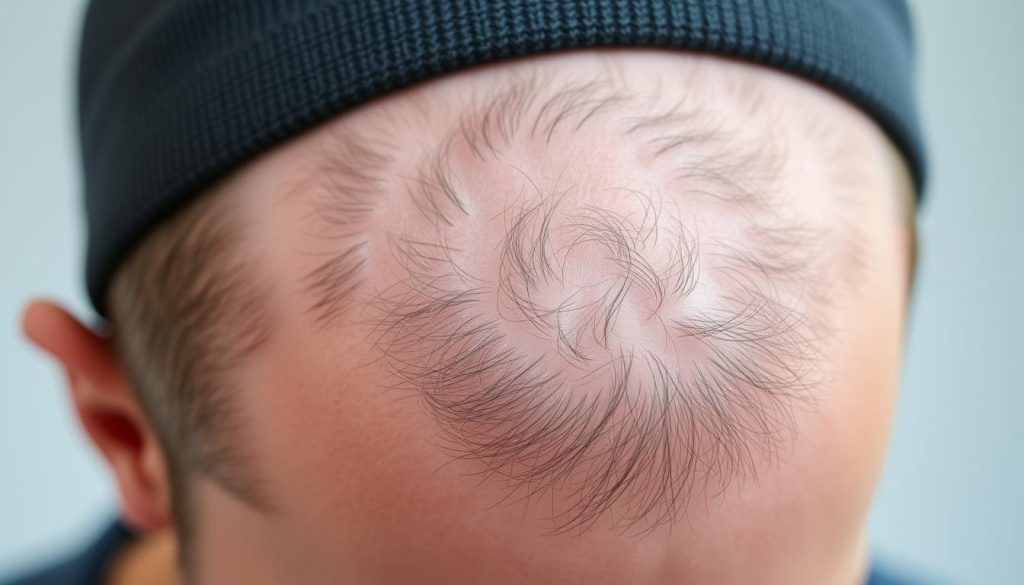
| Hat Wearing Habit | Impact on Scalp Tension | Risk Level for Traction Alopecia |
|---|---|---|
| Frequent Tight Hat Use | High | High |
| Occasional Loose Hat Use | Low | Low |
Wearing hats that fit right and not for too long is key. Learning about scalp tension effects from hats helps us make better choices. This keeps our style and hair healthy.
Friction Alopecia: The Role of Hats in Hair Damage
Wearing hats regularly can affect your hair. Some hats can cause friction alopecia, a type of hair thinning. This happens when fabric rubs against your hair too much. Knowing how to spot the signs of friction alopecia is important for hat wearers.
Identifying Friction Alopecia Symptoms
Spotting friction alopecia early can stop more hair loss. Look out for these signs:
- Noticeable thinning patches where the hat typically rests
- Increased hair breakage in areas subject to friction
- Redness or irritation on the scalp from prolonged hat wear
Ignoring these symptoms can lead to more hair loss. It’s vital to catch them early.
Preventative Measures for Hat Wearers
To avoid friction alopecia, try these tips:
- Choose hats made from soft, natural fabrics to reduce friction
- Ensure hats fit properly, without being too tight
- Limited hat wearing time, particularly during hot weather
These simple steps can help keep your hair healthy. They prevent damage from hats.
In summary, knowing about friction alopecia is crucial for hat lovers. By taking steps to prevent it, you can enjoy hats without harming your hair. This way, you can keep your hair looking great while wearing your favorite hats.
Traction Alopecia: Can Tight Hats Lead to Hair Loss?
Many people wear hats every day for fashion or practical reasons. But, worries about hat baldness and hair thinning from hats are common. Traction alopecia is a hair loss issue caused by constant pulling on hair roots.
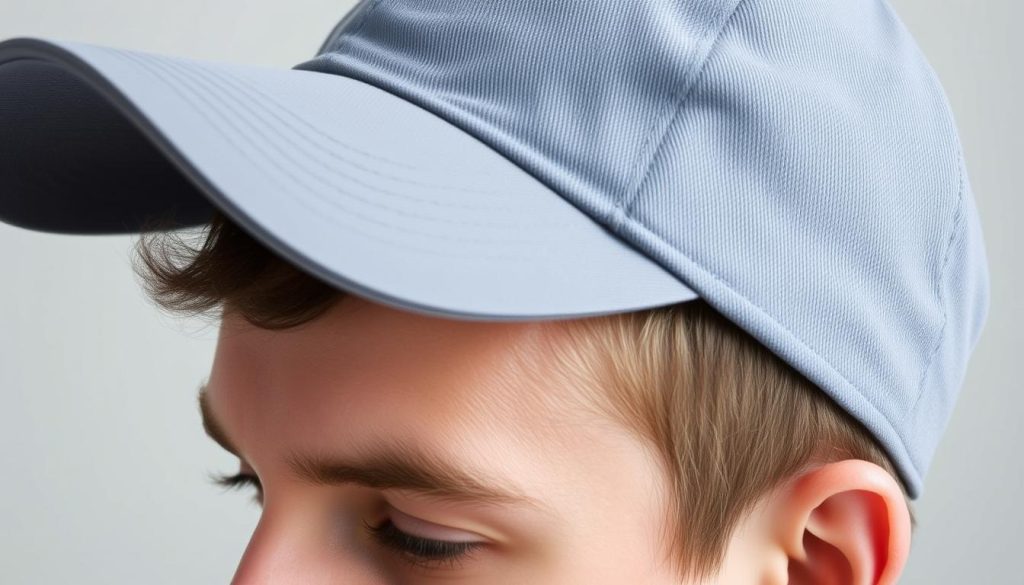
This hair loss is often linked to tight hairstyles. But, wearing hats too tightly can also cause problems. Hats that fit too snugly can damage hair follicles and lead to thinning.
If you’re worried about your hat’s effect on your hair, learning about traction alopecia is key. Research shows that constant hair tension can harm hair growth. This can weaken hair and cause more shedding.
To avoid hair loss, pick hats that fit loosely. This reduces pressure and improves scalp blood flow. Also, change up your hat style and position to avoid too much tension. For more tips on keeping your hair healthy while wearing hats, check out Health with Style.
While hair thinning from hats and hat baldness are big concerns, it’s vital to balance hat-wearing with good hair care. Learning about traction alopecia and how to prevent it can help keep your hair and style in check.
To wear your hats in a way that’s good for your hair, follow these tips:
- Opt for hats with adjustable bands to lessen scalp pressure.
- Don’t wear tight hats for too long.
- Go for soft, breathable materials like cotton or silk to prevent irritation and ensure airflow.
Knowing about traction alopecia helps hat enthusiasts avoid unnecessary hair thinning from hats. Let’s enjoy our favorite styles while taking care of our hair’s health.
Hat Baldness: Debunking the Dangers of Daily Hat Use
Many think wearing hats often causes hair loss. But what does science say? This section clears up myths about hat baldness and how hats affect our scalps.
Dispelling Common Hair Loss Misconceptions
For a long time, people believed hats cause permanent hair loss. But, research and dermatologists say it’s not that simple. Let’s look at what really affects hair health when wearing hats.
Frequency and Duration: How Often is Too Often?
It’s important to know how often hats can harm hair. Wearing hats every day doesn’t mean you’ll lose your hair. The type of hat, how tight it is, and how long you wear it matter more. Choosing the right hat and wearing it wisely is key to scalp health.
To keep your scalp healthy and prevent hair loss from hats, follow these tips:
- Opt for hats made from natural, breathable materials to avoid sweat buildup.
- Steer clear of tight hats that can cut off blood flow and weaken hair roots.
- Don’t wear hats all day; give your scalp breaks to breathe.
In summary, hat baldness is a big topic, but we should stick to the facts. Wearing hats daily is not bad if done right. Focus on the hat’s quality and fit to keep wearing hats stylish and safe.
Hat Hair Damage: The Impact of Material and Design
It’s important to know how hat materials can affect hair health. The right hat materials can help avoid hair damage. This way, you can keep your hair healthy while still looking stylish.
The Importance of Choosing the Right Hat
Choosing the right hat is more than just picking a style. It’s about preventing hair damage. Cotton, silk, and satin are good choices because they cause less hair breakage.
- Cotton: Breathable and gentle on the hair follicles
- Silk: Reduces friction and prevents moisture loss
- Satin: Helps in retaining hair hydration
Look for hats with these materials, especially where they touch your hair. This can help prevent hair thinning.
Textile Allergies and Scalp Health
Some people might have allergies to certain hat materials. These allergies can make your scalp itch and even cause hair loss. Knowing what materials touch your skin is key.
Talking to a dermatologist about these allergies can help. They can suggest hypoallergenic materials that won’t irritate your scalp.
In short, the material of your hat is more important than its design. Choosing the right materials and ensuring a good fit can protect your hair. This way, you can enjoy fashion without harming your hair.
Hat Folliculitis: Spotting the Signs
If you often wear hats, it’s key to know the signs of hat folliculitis for good scalp health. This issue, often caused by bacteria in tight or dirty hats, can harm your hair if not treated fast.
Folliculitis makes hair follicles inflamed, leading to itchy, red bumps. If you wear hats a lot, spotting early signs is vital to keep your scalp healthy.
Symptom Awareness: Watch for redness, itchiness, and pimples at hair roots, especially where hats sit. Pustules, looking like small blisters, show infection.
Handling this issue means good hygiene and picking the right hat materials. Use breathable fabrics and clean hats often to stop hat folliculitis.
| Signs of Hat Folliculitis | Preventive Measures |
|---|---|
| Itchy, red bumps on the scalp | Choose breathable hat materials |
| Pain or tenderness in the affected area | Ensure hats are clean and dry |
| Formation of pustules or blisters | Limit hat wearing time, especially in hot weather |
Spotting these signs early can stop hat folliculitis from getting worse. It helps keep your scalp healthy. By following these tips, hat lovers can stay stylish without harming their scalp.
Hair Care Tips for Regular Hat Users
Wearing hats often? Keeping your hair and scalp healthy is key. To avoid hat hair damage, follow specific hair care tips. With the right scalp care and hair routine, you can enjoy hats without harming your hair.
Maintaining a Healthy Scalp Environment
Wearing hats often can affect your scalp. Hats can block air and cause sweat, leading to skin problems. To keep your scalp healthy, try these tips:
- Choose breathable hat materials to minimize sweat accumulation.
- Wear hats that fit properly; overly tight hats can restrict blood flow and cause tension.
- Use hair products that balance scalp oil production without over-drying.
Essential Hair Care Products and Techniques
For those who wear hats a lot, picking the right hair care is crucial. Here are some key products and techniques:
- A gentle, sulfate-free shampoo to reduce irritation and moisture loss.
- Moisturizing conditioners that reinforce hair’s natural defenses against mechanical stress.
- Lightweight, non-greasy hair serums that can add a layer of protection without weighing hair down.
- Regular deep conditioning treatments to replenish moisture and resilience.
Using these hair care products can help keep your hair and scalp healthy. This way, you can prevent hat hair damage and enjoy your hats.

Does Wearing Hats Cause Hair Loss? Investigating the Evidence
Many people wonder if does wearing hats cause hair loss. To find out, we looked at scientific evidence from dermatology journals and hair loss reports. This helps us understand if there’s a link between hats and hair thinning.
Studies have looked into hair thinning from hats. They examined how hat pressure and friction might harm the scalp and hair follicles. It’s important to understand these studies to separate fact from fiction.
| Study | Participant Number | Findings |
|---|---|---|
| Comprehensive Scalp Analysis 2018 | 500 | No significant hair loss attributed solely to hat usage |
| Frictional Follicle Stress Study 2020 | 300 | Minor inflammation in subjects wearing very tight hats |
| Longitudinal Hat Wear and Hair Health Project 2021 | 450 | No correlation between regular hat wearing and hair thinning |
This data shows different study results. It helps us understand does wearing hats cause hair loss. While tight hats might cause some scalp issues, regular hat use doesn’t lead to hair loss or thinning.
It’s key for hat enthusiasts to know this. The scientific evidence tells us that the right fit and material are more important than just wearing a hat.
Hat Seborrheic Dermatitis: Is Your Hat to Blame?
Scalp conditions like hat seborrheic dermatitis can be affected by the type and how often you wear hats. This condition causes scaly patches and red skin, mainly on the scalp. It’s important to look into how hats might damage hair and worsen scalp problems.
Seborrheic dermatitis is a scalp issue that can be influenced by many things. Hats made from wool or synthetic materials can irritate the skin and make symptoms worse. Hats that trap heat and moisture can also help yeast grow, making the scalp condition worse.
Wearing a hat does not cause seborrheic dermatitis, but if you are predisposed to this condition, a hat might trigger or worsen the symptoms.
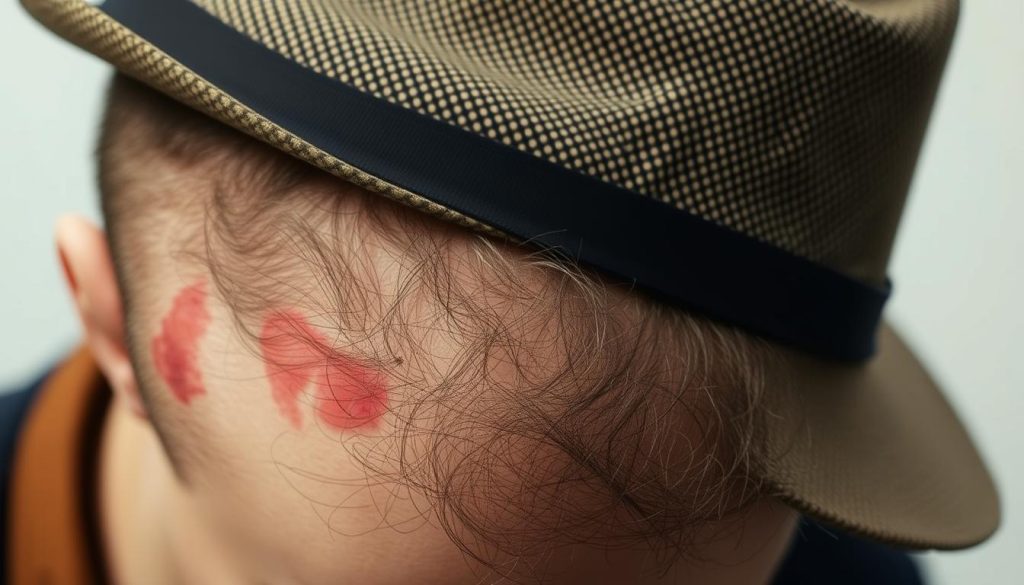
- Choose hats made from natural fibers like cotton which allow the scalp to breathe.
- Ensure that hats are loose-fitting to reduce friction and avoid aggravation of the scalp.
- Wash hats regularly to decrease the build-up of skin oils and sweat.
It’s key to understand your scalp’s health and how it reacts to different environments. By picking the right hat and keeping it clean, you can avoid hat hair damage and keep your scalp healthy.
| Hat Material | Benefits | Risks |
|---|---|---|
| Cotton | Breathable, reduces irritation | May retain moisture if not treated |
| Wool | Warm, durable | Potentially irritating, can trap heat |
| Synthetic Fibers | Lightweight, versatile | Can irritate sensitive skin, traps sweat |
How to Combat Hat Dandruff and Protect Your Scalp
Fighting hat dandruff means making smart choices in hats and hair care. Knowing how to pick the right headwear and follow good hair care can help a lot. It makes your scalp feel better and keeps your hair healthy.
Choosing the Correct Headwear for Scalp Conditions
When picking a hat, think about scalp protection first. Hats made of breathable materials like cotton or silk help. They keep moisture away and reduce scalp irritation.
- Look for hats with adjustable bands to avoid tight fits that can harm scalp circulation.
- Choose hats that draw moisture away if you’re active, helping keep your scalp dry and healthy.
Dandruff-Friendly Hair Care Routines
Make a hair care plan that’s good for your scalp to fight hat dandruff. Washing your hair regularly with dandruff-specific shampoo is key.
- Apply anti-dandruff products gently to avoid irritating your scalp more.
- Use soft brushes or combs to lessen scalp stress.
- Condition often to keep your scalp moisturized.
| Feature | Benefit |
|---|---|
| Lightweight Materials | Reduces strain on hair follicles and prevents scalp stress. |
| Adjustable Size | Prevents excessive compression, allowing proper circulation. |
| Breathable Fabric | Keeps the scalp dry and lowers the potential for dandruff. |
By matching proper headwear choices with hair care for dandruff, you can manage hat dandruff well. This way, you can look good and keep your scalp healthy at the same time.
Expert Opinions: What Dermatologists Say About Hat Hair Loss
There’s a big debate about whether hats cause hair loss. Dermatologist insights offer a clear view. They say hats don’t directly cause hair loss. But, they can make problems worse if you already have them.
Experts at trichology conferences have shared important points. They say it’s key to know the difference in hat-related hair issues. Things like the hat’s material and how it fits are very important.

- Wearing tight hats for a long time can hurt blood flow. This can weaken hair follicles over time.
- Wearing hats that don’t let air through can cause scalp irritation. This can make hair fall out faster.
- Putting on and taking off hats can stress hair follicles. This is especially true if your hair is brittle or your scalp is dry.
Dermatologists often ask people to wear hats in moderation. They also recommend choosing hats that are good for your scalp. Keeping hats clean and fitting well can also help avoid scalp stress and hair thinning.
While hats might not cause hair loss for most, certain situations can increase the risk. Listening to what dermatologists say about hat baldness can help you keep your hair and style in check.
Diet and Lifestyle: Additional Factors in Hair Loss
Genetics and the environment often get a lot of attention when it comes to hair loss. But, it’s also important to think about how our lifestyle choices, like what we eat and how stressed we are, affect our hair. Knowing about these factors can help us take better care of our hair.
Role of Nutrition in Hair Health
What we eat has a big impact on our hair. Not getting enough of certain nutrients can make our hair weak and lead to more hair loss. Eating a balanced diet with lots of vitamins, minerals, and proteins is key to keeping our hair follicles healthy and our hair growing well. Here’s a list of important nutrients and where to find them to help your hair stay healthy.
| Nutrient | Source | Benefits |
|---|---|---|
| Vitamin A | Carrots, Spinach, Sweet Potatoes | Supports sebum production in the scalp |
| Vitamin C | Citrus Fruits, Strawberries, Peppers | Helps build collagen and aids iron absorption |
| Vitamin E | Almonds, Sunflower Seeds, Avocado | Protects the scalp from oxidative stress |
| Iron | Red Meat, Lentils, Spinach | Facilitates oxygen delivery to hair roots |
| Protein | Chicken, Eggs, Quinoa | Strengthens hair strands |
| Zinc | Oysters, Beef, Pumpkin Seeds | Plays a role in hair tissue growth and repair |
Stress and Hair Loss: An Overlooked Connection
Stress is a big part of our lives today and it can cause hair loss. This is especially true for conditions like telogen effluvium, where hair falls out too soon. To fight stress and its effects on our hair, we need to find ways to relax, like through mindfulness, exercise, and getting enough sleep.
It’s important to see how our daily choices, like what we eat, and bigger issues like stress, all play a role in hair loss. This shows we need to tackle hair loss from many angles.
Conclusion
As we finish our talk, we’ve cleared up myths about hair loss and hats. Hats don’t directly cause hair loss. But, we found that certain hat-wearing habits can damage hair.
Conditions like traction alopecia and folliculitis are real concerns for hat wearers. These issues can happen if hats are worn too tight or with too much friction.
Our findings show the importance of picking the right hat materials and wearing them correctly. It’s key to balance style with hair and scalp health. If you notice hair loss, see a doctor to check for health issues.
For more info, check out this comprehensive guide.
In the end, enjoying hats is all about making smart choices. By being aware of how we wear hats, we can keep them a safe part of our wardrobe. So, wear your hats proudly, knowing your hair will stay healthy with the right care.
FAQ
Does wearing hats cause hair loss?
The American Academy of Dermatology says wearing hats usually doesn’t cause hair loss. It’s a common myth without scientific backing. Hair loss is often due to genetics, hormonal changes, or medical conditions, not hats.
Can hair thin from wearing hats?
Normal hat-wearing is unlikely to thin your hair. But, very tight hats might cause traction alopecia. This is hair loss from constant pulling on hair follicles, as the International Journal of Trichology explains.
What is friction alopecia, and can hats cause it?
Friction alopecia is hair loss from repeated friction. If a hat is too tight and rubs against the scalp, it might cause this, Clinical Trichology Studies say. But, it’s rare and usually involves more than just hat-wearing.
How can tight hats lead to traction alopecia?
Traction alopecia happens when hair roots face too much tension, like from tight hats. The Journal of Investigative Dermatology Symposium Proceedings says this strain can damage follicles and lead to hair loss over time.
Can daily hat use contribute to baldness?
Daily hat use alone doesn’t cause baldness. The myth of hat baldness has been debunked. Research shows hat wearing as a habit doesn’t lead to hair loss. Genetics are the main cause of baldness.
Does the material and design of hats affect hair health?
Yes, hats’ material and design can impact hair health. Hats with abrasive materials or tight bands may cause friction or tension. Choosing soft, breathable materials and well-fitted designs can help prevent hair damage, Textile Industry Standards suggest.
What is hat folliculitis and how can I spot it?
Hat folliculitis is inflammation of hair follicles, often from bacteria or fungi, made worse by tight hats. Look for redness, itching, and small bumps around hair follicles, Clinical Dermatology Case Reports advise.
Are there any specific hair care tips for regular hat users?
For hat users, keeping the scalp healthy is crucial. Use gentle shampoos, avoid tight hats, and let your hair dry before wearing a hat. Choose hats made from natural materials to prevent damage, Scalp Health Practitioners recommend.
Could a hat worsen conditions like seborrheic dermatitis?
Hats might worsen scalp conditions like seborrheic dermatitis by trapping moisture. This creates an environment for yeast to grow. Manage seborrheic dermatitis with medicated shampoos and avoid hats that make the scalp sweat, Clinical Dermatology Research Papers suggest.
How can I combat hat dandruff?
To fight hat dandruff, choose breathable hats and keep a clean scalp. Use anti-dandruff shampoos and ensure hats are clean. Give your scalp breaks from hats when you can, Dandruff Treatment Guidelines advise.
What do dermatologists say about hat hair loss?
Dermatologists generally agree that normal hat-wearing doesn’t lead to hair loss. However, they warn against tight hats that can cause traction alopecia if worn often and for long periods, board-certified dermatologists say.
How do diet and lifestyle affect hair loss?
Diet and lifestyle are key to hair health. Nutritional deficiencies can cause hair thinning, and stress can lead to hair loss conditions like telogen effluvium. This is according to Nutritional Science Journals and studies on Psychological Stress and Hair Loss.












